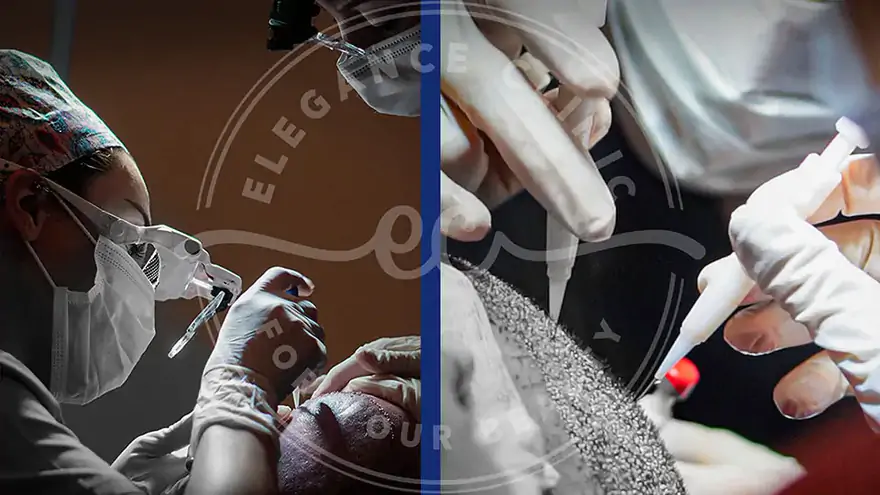Hair Transplant Methods: Differences Between FUE and DHI

Hair transplant methods are among the most frequently researched aesthetic solutions today by people who want to get rid of hair loss permanently. Although hair loss is more common in men due to genetic predisposition, it can also occur in women because of stress, hormonal changes, nutritional disorders, and environmental factors. For people experiencing intense hair loss, hair transplantation has become an effective treatment option that offers natural-looking and long-term results.
The techniques used in hair transplantation have advanced with the development of technology and have become more comfortable. Nowadays, patients experience a much smoother process both during and after the operation, the recovery period is shorter, and the success rate is higher. In this context, the most preferred hair transplant methods are FUE hair transplant and DHI hair transplant. Both methods provide safe and permanent results, but they differ in terms of application, advantages, and procedure.
What is FUE Hair Transplant?
FUE hair transplant (Follicular Unit Extraction) is a technique based on collecting hair follicles one by one from the donor area with the help of a micromotor and placing them into pre-opened microchannels. Since the FUE method does not require surgical incisions or stitches, it offers a more comfortable recovery process for the patient. Thanks to this feature, it has become one of the most frequently applied hair transplant methods in recent years.
The micromotor devices used in the FUE technique are extremely precise. This way, the hair follicles can be extracted without damage, and the transplanted grafts grow healthier. The FUE method is particularly successful when it is necessary to restore dense hair in wide bald areas. It is also preferred in operations where a large number of grafts are required, which is one of the reasons for its widespread use.
In the advanced version of FUE, called Sapphire FUE hair transplant, the channels where the follicles will be placed are opened with special sapphire blades. Thanks to this method, minimal tissue damage occurs, the recovery period is shorter, and the direction of the transplanted hair can be adjusted more naturally. The advantages of sapphire blades make the post-transplant results more aesthetically satisfying.
Advantages of FUE Hair Transplant
- No surgical incision or stitches are required, so the recovery process is very comfortable.
- Patients can usually return to daily life within 1 week.
- Effective results are achieved in areas with significant hair loss thanks to a high graft count.
- A natural hairline can be achieved.
- The risk of scarring is extremely low.
What is DHI Hair Transplant?
DHI hair transplant (Direct Hair Implantation) is a modern technique where hair follicles are collected with a micromotor and directly implanted into the recipient area using special Choi implanter pens. In this method, channel opening and graft implantation are performed simultaneously. Therefore, the hair follicles remain outside the body for a shorter time and have a higher survival rate.
DHI hair transplant is particularly successful in cases where hair loss is not complete, but thickening of sparse areas is desired. Since the direction of hair growth is preserved during the procedure, the results are aesthetically very natural. Its preference for the frontal hairline and areas that require density has made this method increasingly popular.
For the DHI technique to be applied, the donor area must have sufficient hair density. In addition, this method requires more time and precision compared to other techniques, so it should be performed by experienced specialists. In this way, both the success rate and patient satisfaction increase.
Advantages of DHI Hair Transplant
- Since grafts remain outside the body for a minimal time, the risk of follicle loss decreases.
- High-density transplantation can be performed between existing hairs.
- The angle and direction of the hair can be controlled more precisely.
- Bleeding and scabbing are reduced.
- The results appear denser and more natural aesthetically.
Differences Between FUE and DHI Hair Transplant
| Feature | FUE Hair Transplant | DHI Hair Transplant |
|---|---|---|
| Graft Extraction Method | Extracted one by one with a micromotor | Extracted with a micromotor |
| Graft Placement | Manually placed into pre-opened channels | Directly implanted with a Choi pen |
| Recovery Time | 7-10 days | 5-7 days |
| Ideal Use | Wide bald areas | Thickening of sparse areas |
| Procedure Duration | Can be shorter | Can be longer |
| Cost | More economical | Can be higher |
Frequently Asked Questions (FAQ)
1. Who is suitable for hair transplant?
Anyone over the age of 20, with a sufficient donor area and in good general health, is a suitable candidate for hair transplant. The degree of hair loss and hair type are also important factors in the selection process.
2. How to choose between FUE and DHI hair transplant?
The choice depends on the extent of hair loss, hair type, and personal expectations. For large bald areas, FUE hair transplant is more suitable, while DHI hair transplant is ideal for thickening sparse areas.
3. Is hair transplant painful?
The procedure is performed under local anesthesia, so no pain is felt during the operation. Mild sensitivity may occur afterward, but this is temporary.
4. When does the hair grow after transplant?
In the first weeks after the operation, shock loss may occur. Permanent hair begins to grow from the 3rd month, and natural, lasting results are achieved within 6-12 months.
5. What should be considered after hair transplant?
In the first days, the head should be protected from trauma, prescribed medications should be taken regularly, and the doctor’s instructions should be followed. Sleeping position, hygiene, and hair care rules are also crucial during the recovery process.
